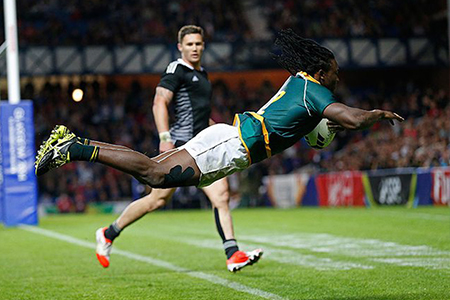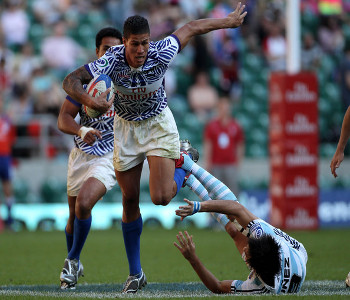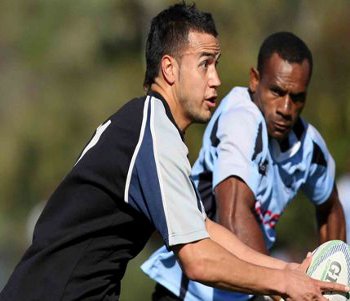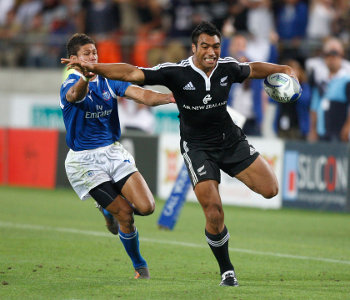Sevens is a game that one can play in any position with reasonable success at the lower levels, but as you progress it becomes a lot more specialized. Some items here are also found in my previous articles on playing prop in sevens, playing hooker in sevens, playing scrumhalf in sevens, playing flyhalf in sevens, and playing center in sevens, and are important if reading this piece by itself.

What is required to play wing?
The wing position requires acceleration off the mark, with high top end speed. Generally the wing is the fastest player on the field, and able to beat people one-on-one. In today’s modern game the wing also needs to be quite physical, having to bust through tackles. The player needs to be a finisher, which means they have a sense for the try line; using speed, misdirection in the form of sidestepping or swerving, and vision to score tries. On defense the wing must be an excellent open field tackler. The wing could be a fullback, center or wing in XVs rugby. Obviously many of these statements are generalizations, but are based on my own experience in sevens.
Kickoffs kicked: In previous articles we have mentioned three different types of kickoffs. If the kickoff goes deep (near the opposition 22m area) then the role of the wing is to ensure the defensive line comes up together, with all six players in a line next to each other. It is important that no one shoots out of this defensive alignment; otherwise it will create an easy attacking opportunity for the opposition. The wing does not hang back like in XVs rugby – with the sweeper covering any kick through.
If the kickoff is made in the middle of the field (around the 10-15m area) the wing must come up with the center in case the ball gets knocked in his/her direction.
For a traditional shallow kickoff to one of the sidelines, the wing (who is usually on the opposite side of that kickoff) still comes up with the rest of the defense line.
When kicking off, be on the lookout for some gaps on the wing’s side of the field, as teams sometimes focus on the side that the traditional kickoff is coming. In this way a short 10m-grubber type drop kick for the wing can yield possession for the kicking team.
Kickoffs received: The wing can stand deep (near the 22m area) on the opposite side where the traditional kick is going to take place. If your team claims possession then the wing is in a perfect place to mount an attack. Width and depth are the most important for this counter-attack.
Lineout’s: The winger often tackles his/her opposite number into touch, which is an excellent opportunity to strip the ball carrier and take a quick lineout. Remember the ball just has to travel over the 5m mark, and can now be thrown backwards to your teammates.
The lineout is an excellent attacking opportunity, with the opposition being 20m away. Various set moves can be very effective, and if run correctly can be used at any level of rugby.
Watch the clip below at 1 minute 8 seconds where simple hands across the field after a well-worked lineout sets free the Russian winger. He manages to outstrip the cover defense and sweeper for an excellent try.
While we have this clip open, look at 6 minutes 46 seconds where Fiji have a ruck on their own try line. From that ruck watch the Fijian player sprint towards the sideline dragging all three South African defenders, then do an excellent switch with the player in the wing position. That play is used time and time again with great success at all levels.
Scrums: The scrums are also a great attacking piece, and even if a clean break is not made, a wide ruck is vital for an attacking platform. The center must work very closely with the wing and flyhalf, as it will be up to these three players to secure that wide ruck and send the ball across field.
Often during set pieces there are two gaps the winger can attack. One is out wide, and the other is inside the last defender. The defender covering the center’s channel sometimes doesn’t get into a good position to make that tackle, with the winger using footwork and speed to burst through that gap.
There are hundreds of examples of this, but watch Wang Kuo Feng of Chinese Taipei expose the New Zealanders (who are one of the best defensive teams on the World Series) in Hong Kong in the first try of this clip.
Then 45 seconds into the clip, watch an attack off the scrum from China, with their winger sidestepping a few Australian defenders and sending it towards the other side of the field. His determined attack has created space out wide near where the scrum took place.
Off another scrum – 1 minute 33 seconds – watch Scotland use a set move to take the ball wide. Then a deep switch with the winger brings the ball back towards where the scrum was, and opens up space for the attackers.
Samoa’s Mikaele Pesamino is one of the best finishers in the game, which is illustrated at 3 minutes 20 seconds where he shows his top end speed for a sensational try against England.
Watch 4 minutes 15 seconds, which shows England wing Mat Turner using his speed and anticipation to run a great support line for Ben Gollings, who puts an excellent kick through for his winger.
In the traditional sevens pattern, the ball goes from one side of the field to the other, with a pullout happening on the ends. This pull out, where a support player is 10m or more in support directly behind the winger, with a short runner sucking in the defenders, leaves the winger sometimes with a half gap to attack.
Defense: The role of the wing on defense is different from most positions.
Let me explain the term ‘closing the gate’ (it has various names) but occurs when the defensive team plays a softer defense on the sideline, enticing the offensive wing (or last player) to carry the ball further than he/she should.
The defense uses 5 players to ‘squash’ the offence against the touchline. This is called ‘closing the gate’ as the defenders mimic that motion. A good attacking team will either set up a ruck near the touchline – forcing the defenders to get back on side – or they will use the deep pocket pull-out maneuver to try escape the defensive pressure.
If the team is playing a drift defense (6 defenders vs. 7 attackers, as one defender is a sweeper/fullback) and they are wanting to ‘close the gate’ then the center will push across the field and eventually tackle the offensive wing in that scenario. This leaves the defensive wing to take a late loop or offload should that be needed. Other times it will be man-on-man during defense off a set piece.
In open play the defense will be sliding/drifting across the field as they have only 6 defenders against 7 attackers. In this scenario always leave the attacker further from the ball, as you can always play a softer defense should the ball reach that extra player.
Attack:
The wing is all about finishing. This means top-end speed and beating defenders one-on-one. Some of the best wingers in the world have a great kick through in case they need it.
Support play for the wing is also vital, with the speedster often drawing in one or more defenders, looking to setup another runner for the try.
Another necessary skill for a winger is the ability to stay inbounds whilst diving over for a try in the corner. Often the defense is tackling the winger as he/she dives over, so grounding the ball before putting a body part into touch is an important skill.
In the following clip New Zealand have an attacking scrum at the 45-second mark. A simple pin and loop move sees scrumhalf Tamasi Cama go around flyhalf Toby Arnold to send winger Frank Halai down the touchline. Halai draws in two defenders and with excellent support play by Cama, it’s an easy looking try.
At 1 minute 2 seconds in the same clip, watch winger Halai pop up in the center position, busting through tackles to free Arnold for another score.
Have a look at 2 minutes 58 seconds in which captain DJ Forbes sets up Tim Mikkelson on the outside. The winger does a superb job putting his head down and sprinting down the touchline for a vital score in the corner.
Both England speedsters Dan Norton and Dan Caprice have the ability to create space through sidestepping and pure speed. Watch 43 seconds into the clip as both Norton steps his way out of trouble, then the ball goes wide to Caprice who does brilliantly to stay inside the try zone for a 5 pointer.
Then at 1 minute 2 seconds watch how the slippery Norton pulls two defenders onto him, whilst opening space out wide for another excellent worked try scored by Simon Hunt.
At 1 minute 50 seconds watch winger Norton (who could step you in a phone booth) weave his way through a couple defenders and then send a beautifully timed pass to the support runner Ben Gollings. You can see they have practiced that many times.
Later at 2 minutes 40 seconds watch the width and depth of Norton again, bursting onto the pass down the touchline. Another perfect inside ball to Gollings yields yet another brilliant try.
Norton’s highlights continue at 4 minute 2 seconds where he burns down the sideline and then steps inside the sweeper for a brilliant solo effort.
Then at 4 minutes 27 seconds watch the accurate kickoff from flyhalf Ben Gollings, which is superbly claimed by his forwards. This possession wins the match for England, with replacement winger Mat Turner able to cut through the defense for a superb score.
A winger should also be able to put the ball onto the foot for either his/her teammates or for themselves. Watch 7 seconds into the clip as French winger Renaud Delmas collects his own grubber to get past South African speedster Ryno Benjamin. Delmas – who is right footed – kicks the ball at a beautiful angle knowing he is almost out of bounds and is then able to pick it up with a few meters to spare.
Then at 1 minute 23 seconds watch Kenyan winger Humphrey Kayange slice through on the outside, and then deliver an unbelievable pass to Collins Injera for the score.
At 2 minutes 13 seconds, look for the classic inside switch with the center and winger. Australia’s James Stannard takes the defense wide sucking in both his opposite center and wing, with Clinton Sills coming off the touchline to collect that switch ball.
Sills then uses his blistering speed at 3 minute 13 seconds to score for the Australians.
Best wings in the world?
Some of my favourite wings of all time include: Mikaele Pesamino of Samoa, Mike Palefau from the USA, and New Zealand’s Victor Vito.
All of these players have the ability to create scoring opportunities out of nothing, with the speed and vision to change the outcome of a game.

Watch this highlight clip to see Samoa’s Mikaele Pesamino (number 10) at his best. Last year Las Vegas hosted their first ever IRB World Sevens Series event, and Pesamino was on fire for Samoa as they claimed the title. Pesamino is fourth on the most tries scored list with 158. He is also 12th on the all time most points table with 822.

Unfortunately there isn’t that many filmed highlights of USA’s Mike Palefau (number 11) in action. During the 2007/2008 season Palefau was involved in many historic wins for the USA, as they established themselves as a core sevens side on the circuit. Watch at 10 minutes 15 seconds as Palefau eludes three defenders to score against Argentina. What the highlights don’t show is his first try in that match – running all of 70m going coast to coast to setup an excellent win against the highly rated South Americans.
Click here to view video.

Staying with the same clip above, watch some highlights of New Zealaner Victor Vito (number 7) in action. The 2008 Wellington 7s Cup final featured the classic line-up at wing for Samoa’s Pesamino against Vito. The final starts at 21 minutes 27 seconds in the above clip. Checkout the speedster Pesamino who gets on the scoreboard first – unmatched for pace. But Vito comes back at 22 minutes 45 seconds; using his powerful fend, strength and that Maori sidestep! Later center Zar Lawrence (who is featured in the ‘how to play center in sevens’ article) busts through a couple tackles for another brilliant score. Then in the second half at 24 minutes 38 seconds Samoa’s Pesamino realizes there isn’t enough space to get past Vito so he executes a superb chip and chase, sending his teammate over for the score. Lolo Lui (who is featured in the ‘how to play flyhalf in sevens’ article) does his own magic with an unbelievable open field drop-goal.
At 25 minutes 25 seconds, New Zealand has a penalty with 30 seconds left to play. Simple hands to a flying Victor Vito seals the thrilling final as he breaks one tackle to score the winner.
Since then Vito has become an All Black and should feature in the 2011 Rugby World Cup.
Are you a wing?
Acceleration off the mark and top end speed are both vital for the wing position. Having the ability to beat defenders one-on-one is very important, as well as support lines when another teammate has made a break.
Today’s wings are also becoming more and more physical, both on offense and defense. Trytime!
Photo Credits: Getty Images
published by: RugbyIQ
